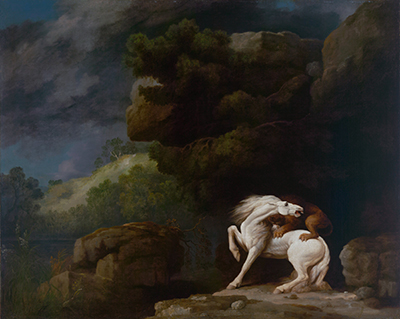The subject matter of a lion attacking a horse was a recurring theme for George Stubbs who had a fascination with this subject, and the artist developed at least 17 works of art primarily in oil including the striking enamel on copper piece which was created in 1769 and now resides in the Tate Gallery.
The painting is considered as Stubb's earliest attempt in enamel and was the first time that an artist of Stubbs' reputation has used this medium. Born in Liverpool in 1724, Stubbs was originally apprenticed to his father's trade of leather-dresser until he was about 16 years old. He then expressed a desire to become a painter and went on to study anatomy in York and also worked as a portrait painter.
The lion attacking a horse painting is an enamel on copper piece, and the artist has cut the corners to form a distinctive irregular octagon which gives a more intense focus to the subject matter. The reason why Stubbs first used this technique is unclear but could have been artistic curiosity or possibly a combination of scientific and creative reasons, and Stubbs spent an inordinate amount of time preparing and researching diverse elements of his work before he began.
Due to his almost obsessive traits of researching the subject matter of planned artwork, the horses of Stubbs were viewed by contemporaries as more accurate than that of some previous painters. In earlier paintings the anatomy and structure of a horse were often portrayed with less than realistic anatomy and proportions. In the painting 'A Lion Attacking a Horse,' the image evokes a visceral and immediate response, and the fear in the body and face of the animal are almost palpable as the lion sinks it's teeth and claws into the horse's flanks. The realistic musculature and proportions of the animal are a testament to the extensive studies of anatomy and observation of horses undertaken by Stubbs prior to commencing the artwork.
There has been much speculation about why Stubbs was so interested in this particular subject matter with some sources suggesting it was an incident witnessed in North Africa. However, this was later disproven and it remains unclear as to what influenced the painter, although there are also suggestions that the style may be similar to some Greek sculpture that Stubbs has seen in travels to Rome.




